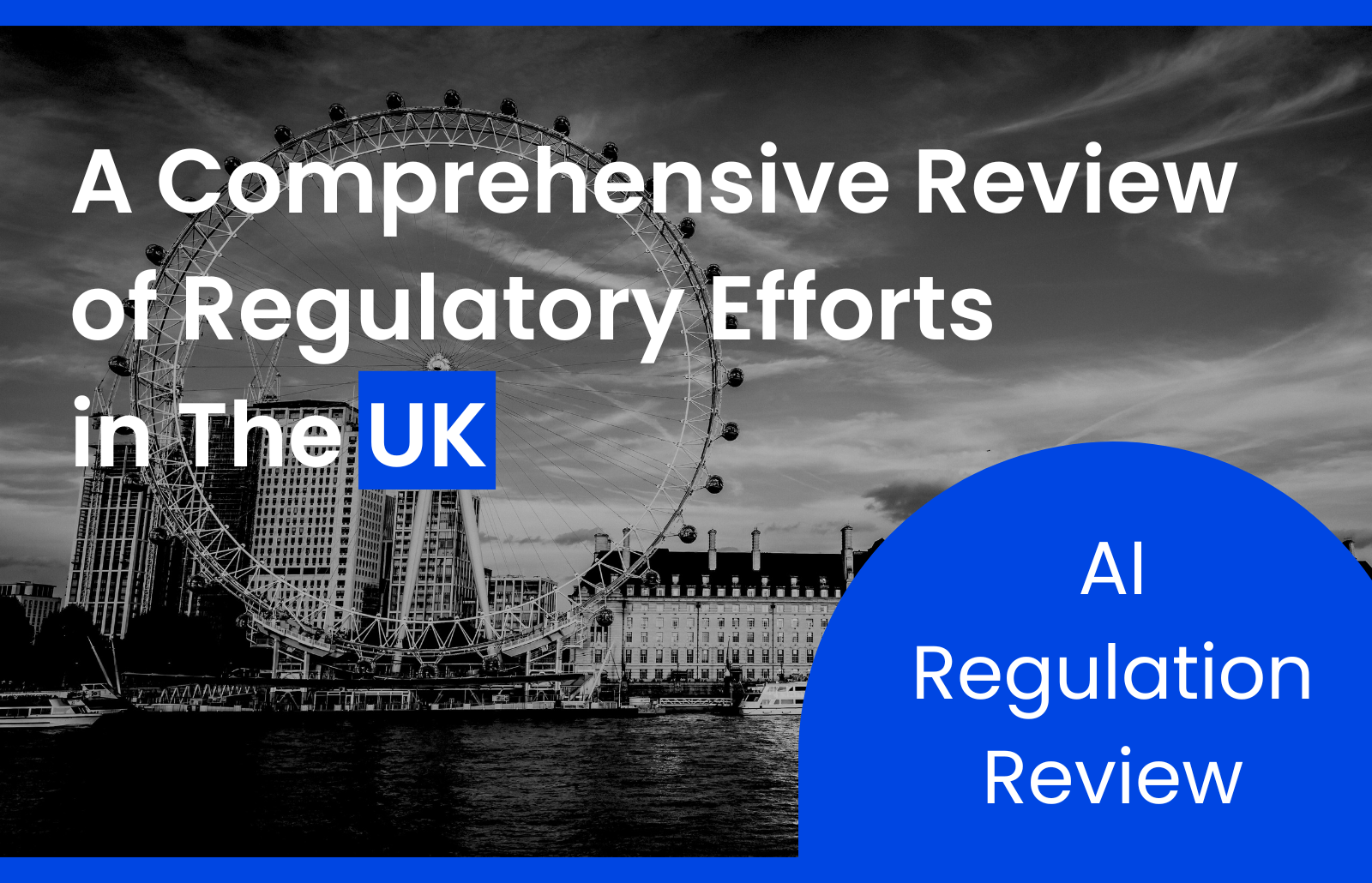Introduction
In recent years, the rapid advancement of artificial intelligence (AI) has brought about transformative changes across various sectors, from healthcare to finance, and beyond. However, with these advancements come challenges, particularly concerning ethics, privacy, and accountability. To address these concerns, governments worldwide are implementing regulations to ensure that AI technologies are developed and used responsibly.
In the UK, AI regulation efforts have been gaining momentum, aiming to strike a balance between innovation and protection. Let’s delve into the current state of the UK AI regulation landscape, exploring recent developments and the implications of the UK spring budget on AI-related initiatives!
The UK Poised for AI Boom: A Thriving Market with Global Ambitions
The UK’s artificial intelligence (AI) industry is a powerhouse, currently valued at over $21 billion. Experts predict a staggering ten-fold growth, reaching a potential valuation of over $1 trillion by 2035. This positions the UK as the third-largest AI market globally, following in the footsteps of the US and China.
Several factors contribute to the UK’s strength in AI. The government plays a vital role in implementing a robust National AI strategy. This strategy is backed by significant financial support, with over $1.3 billion recently allocated to bolster the sector. This builds upon previous investments, bringing the UK government’s total contribution to AI to an impressive $2.8 billion.
Beyond government support, the UK boasts a thriving AI ecosystem through the National AI Action Plan. Vibrant research activity fuels innovation, attracting major venture capital funding and nurturing a burgeoning startup scene. Additionally, businesses across various sectors are actively adopting AI technologies, further solidifying the UK’s position as a global leader in the field.
The UK Leads the Charge in Safeguarding AI
The UK government has been at the forefront of ensuring the safe development and deployment of artificial intelligence (AI). Their commitment to responsible AI advancement is evident in groundbreaking initiatives like hosting the world’s first-ever AI Safety Summit in 2023. This historic event brought together key players – industry leaders, academic experts, and civil society representatives – alongside representatives from 28 leading AI nations and the European Union.
The summit culminated in the Bletchley Declaration, a landmark agreement that marks a global commitment to responsible AI development. Signatories pledged to share the responsibility of mitigating risks associated with advanced AI, fostering collaboration on safety research, and harnessing the positive potential of AI for the benefit of humanity.
This demonstrates the UK’s dedication to fostering a global conversation around AI safety and taking concrete steps towards responsible development.
Simultaneously, experts warn that taking this stance may eventually leave UK unable to compete with the global players because over protection may hinder progress. The jury on whether the UK is taking the right approach with cautious first steps is to be seen.
Unveiling the Roadmap: A Look Inside the UK AI Regulations
When looking at the general state of AI legislation in the UK, several key developments and documents should come into consideration, including:
1. Deep Dive: The Artificial Intelligence (Regulation) Bill [HL]
The Artificial Intelligence (Regulation) Bill [HL], currently making its way through the UK House of Lords, is a significant piece of legislation with far-reaching implications. Here’s a comprehensive analysis to unpack its details:
Origins and Purpose
- Private Member’s Bill: Introduced by Lord Holmes of Richmond (Conservative) in November 2023, it reflects individual initiative within Parliament, not a direct government proposal.
- Addressing the AI Landscape: The bill acknowledges the burgeoning field of AI and aims to establish a regulatory framework to ensure its safe, ethical, and responsible development and deployment in the UK.
Key Proposals
- Establishment of the AI Authority: A central body tasked with overseeing UK’s AI regulation. Its functions may include:
- Oversight and Coordination: Ensuring existing regulators, like the Competition and Markets Authority (CMA), consider AI-specific concerns when fulfilling their mandates.
- Gap Analysis: Identifying areas where current regulations fall short in addressing AI risks.
- Promoting Innovation: Facilitating an environment that fosters responsible AI development while minimising unnecessary burdens on businesses.
- Public Engagement: Educating the public about AI and fostering dialogue on its ethical implications.
Principles for AI Regulation
The bill proposes enshrining specific principles in law to guide AI development and use. These principles might encompass:
- Safety: Designing and deploying AI systems that minimise risks of harm to individuals and society.
- Transparency: Ensuring understandability and explainability of AI decision-making processes.
- Fairness: Mitigating bias and discrimination arising from AI algorithms.
- Accountability: Establishing clear lines of responsibility for the development, deployment, and outcomes of AI systems.
- Privacy: Protecting individual privacy and ensuring responsible data collection and use for AI development.
Current Stage and Potential Impact
- Second Reading Debate: The bill underwent its second reading in the House of Lords on March 22, 2024. Debates focused on the proposed AI Authority’s structure, powers, and proportionality of regulations for different sectors.
- Uncertain Future: As a Private Member’s Bill, its passage through Parliament is not guaranteed. However, it has sparked crucial conversations about AI regulation in the UK and could significantly shape future legislation, even if not enacted in its current form.
Wider Considerations and Research Avenues:
- Alignment with International Efforts: The UK’s approach needs to consider international efforts towards AI regulation to ensure compatibility and avoid creating a fragmented landscape.
- Impact on Specific Sectors: Further research is needed to understand the bill’s potential impact on various sectors like healthcare, finance, and autonomous vehicles.
- Ethical Considerations: Ongoing discussions on the ethical implications of AI, such as algorithmic bias and potential job displacement, need to be factored into the regulatory framework.
2. Navigating the Rapids: The UK’s Pro-Innovation Approach to AI Regulation
The United Kingdom’s commitment to becoming a global leader in artificial intelligence (AI) by 2030 hinges on a crucial factor: fostering innovation while ensuring public trust. This tightrope walk is precisely what the government’s 29th of March 2023, white paper, “AI regulation: a pro-innovation approach,” aims to navigate. Let’s delve into the intricacies of this approach and explore the potential currents it might encounter.
The UK AI Regulation Landscape: A Guide for Businesses
The UK’s approach to regulating AI differs from the EU’s. Here’s what businesses need to know:
- No Single Definition of AI: The White Paper avoids a strict definition of AI, focusing instead on characteristics like adaptability and autonomy. This means regulations may adapt to future technologies. While this offers flexibility, it might create some legal uncertainty.
- Existing Regulators Take the Lead: The government won’t create a new AI regulator. Instead, existing regulators like the ICO and FCA will apply the principles to their sectors using their current powers.
I)- Guiding Five Core Principles for Responsible AI Regulation:
- Keeping AI Systems Safe and Strong
AI should be safe and work properly. Regulators might need to make rules so that the companies making AI systems keep them secure. Regulators should also give advice that matches what other regulators are doing.
- Making AI Understandable and Clear
AI should be easy to understand, and people should know how it makes decisions. This helps people trust AI more, which is important for using it. Regulators need to find ways to make sure that companies using AI explain how it works.
- Holding AI Accountable and in Control
AI should have rules to follow, and there should be people who make sure it follows them. Regulators should make sure everyone involved in making and using AI knows what they should do.
- Solving Problems with AI
If AI makes a bad decision or does something harmful, there should be a way for people to fix it. Regulators should explain how people can challenge bad decisions made by AI and how they can get help fixing them.
- Being Fair with AI
AI shouldn’t treat people or organisations unfairly or make unfair choices. Regulators might need to describe what fairness means for AI systems.
At first, the rules based on these principles might not be laws. But soon, regulators will advise on how to follow these rules, and they might become laws later.
II)- Phased Approach to Regulation
Initially, the principles will be non-binding. Regulators will issue guidance interpreting them for their sectors within a year. The government plans to make these principles a statutory duty for regulators in the future.
III)- Centralised Support Functions
While existing regulators take the lead, the government proposes a central unit to:
- Monitor, evaluate, and assess AI risks.
- Provide central guidance for businesses navigating the AI landscape.
- Offer a multi-regulator AI sandbox for testing AI innovations.
- Facilitate international coordination on AI.
- The Office for Artificial Intelligence might take on some of these functions.
IV)- Generative AI Considerations
The White Paper doesn’t focus heavily on generative AI, but there are two key takeaways:
- The government will clarify the relationship between intellectual property law and generative AI, aiming to provide a voluntary code of practice on copyright and AI.
- The government plans for an AI regulatory sandbox that could be expanded to include generative AI models.
What Businesses Should Do Now:
- Boards should demonstrate oversight of AI risks and regularly discuss AI on the agenda.
- Management should define who is responsible for AI governance and implement policies aligned with the five AI principles.
- Businesses should maintain a register of their AI tools and systems.
- Organisations should stay updated on AI regulations, including the EU’s AI Act and new guidance from UK regulators.
The Global Context: Charting a Course Together
The UK’s pro-innovation approach is not an isolated voyage. It exists within the broader current of international discussions on AI regulation. The European Union (EU) is also developing its own framework, raising questions about compatibility between the two approaches. Collaboration with international partners is crucial to establishing a global standard for responsible AI development, ensuring a smooth journey for the technology across international borders.
By continuously monitoring the development of the UK’s pro-innovation approach and its interaction with international efforts, we can gain a deeper understanding of its potential impact on the global landscape of AI governance. This will allow us to chart a course towards a future where AI flourishes responsibly, benefiting society as a whole.
3. Crafting a Principled Framework: AI Governance in the UK Regulatory Sector
In the United Kingdom, the AI industry is flourishing, positioning itself as a frontrunner in Europe and ranking third globally for private investment. In the past year alone, domestic companies secured a substantial $4.65 billion in investments. The widespread adoption of AI technologies is set to yield significant advantages across various sectors of the economy and throughout the nation.
Examples include the detection of tumours in Glasgow, advancements in animal welfare practices on dairy farms in Belfast, and the acceleration of property transactions in England. Projections for this year anticipate that over 1.3 million businesses in the UK will integrate artificial intelligence into their operations, with investments in the technology estimated to surpass £200 billion by the year 2040.
In contrast to the EU’s centralised AI Act, the UK’s approach to regulating AI governance prioritises a decentralised model. This distributes responsibility amongst various existing regulators, fostering a more nuanced approach tailored to the unique risks and opportunities AI presents across different sectors. This reflects the dynamic nature of AI’s applications, ensuring regulations remain relevant in the face of rapid technological advancements.
This “sector-specific” approach fosters proportionate and adaptable regulation. It avoids a one-size-fits-all approach, allowing for regulations that are more sensitive to the specific risks and benefits of AI in a particular domain. This fosters continued rapid adoption of AI in the UK, potentially boosting productivity and economic growth.
Root Principles
The root principles established by the government serve as a guiding framework for developers and users of AI. These principles emphasise:
- Safety: Ensuring AI systems operate without causing harm.
- Security: Guaranteeing AI systems are robust against vulnerabilities and misuse.
- Transparency and Explainability: Providing clear insights into how AI systems reach decisions.
- Fairness: Mitigating bias and ensuring AI systems do not discriminate.
- Accountability: Establishing clear lines of responsibility for the development and deployment of AI.
- Contestability and Redress: Providing mechanisms for individuals to challenge AI decisions and seek remedy.
Existing regulators, such as the Competition and Markets Authority, the Information Commissioner’s Office, and Ofcom, will be tasked with interpreting and implementing these principles within their respective domains. This leverages existing expertise within these regulatory bodies, promoting a more efficient approach.
Furthermore, these regulators are encouraged to explore “lighter touch” options for fostering responsible AI development. These options might include issuing guidance documents, establishing voluntary compliance measures, or creating regulatory sandboxes. Sandboxes function as controlled environments where businesses can test and refine AI technologies before deploying them in the real world, mitigating risks and fostering innovation.
By adopting a decentralised, sector-specific approach, the UK aims to strike a balance between encouraging responsible AI development and fostering innovation within this rapidly evolving technological landscape.
4. Comparison with EU AI Legislation
Here’s a breakdown of the comparison between the EU and the UK’s AI legislation:
EU AI Act:
- Centralised Approach: The EU aims to establish a single set of regulations (AI Act) overseen by a central body. This ensures consistent application and reduces the regulatory burden for companies operating across the EU.
- Risk-based Classification: The EU categorises AI systems based on their potential risk (high-risk, medium-risk, minimal-risk). High-risk systems (e.g., facial recognition, and social scoring) face stricter controls.
- Focus on Transparency and Fairness: The EU emphasises explainability and bias mitigation in AI development. Users should understand how AI systems work and be protected from discrimination.
UK’s AI Framework:
- Sector-specific Regulation: Different regulators oversee AI in their respective sectors (e.g., finance, healthcare). This allows for a more tailored approach that considers the unique risks and benefits of AI in each field.
- Flexibility for Innovation: The UK prioritises fostering a dynamic environment for AI development. Regulations are designed to be adaptable and not stifle innovation.
- Potential for Inconsistency: The decentralised approach might lead to inconsistencies in how AI is regulated across different sectors.
In Essence:
- The EU prioritises a unified, risk-managed approach with a central authority.
- The UK prioritises flexibility and tailors regulations to specific sectors to encourage innovation.
Here are some additional points to consider:
- Both the EU and UK approaches are still evolving.
- The effectiveness of each approach remains to be seen.
- There might be pressure for future convergence between the EU and UK regulations to facilitate trade and avoid creating a regulatory patchwork.
5. Public Consultation and Industry Feedback on AI Regulation in the UK
The UK government seeks input on its proposed approach to regulating Artificial Intelligence (AI). This public consultation process is designed to achieve two main goals:
- Adapting to a Changing Landscape: The field of AI is constantly evolving. New technologies and applications emerge rapidly. The consultation aims to ensure the regulatory framework stays relevant and effective in this fast-paced environment.
- International Alignment: The UK wants its AI regulations to be compatible with international standards and practices. This harmonisation can benefit businesses operating across borders and avoid creating unnecessary burdens due to conflicting regulations.
Here’s a breakdown of the key aspects involved:
- Public Consultation: This is a process where the government invites the public and relevant stakeholders to provide feedback on a proposed policy or regulation. It allows for a wider range of perspectives to be considered before finalising the rules.
- Industry Feedback: Input from businesses and organisations directly involved in developing and using AI is crucial. They can provide insights into the practical implications of the regulations and suggest ways to make them workable without hindering innovation.
Benefits of Public Consultation and Industry Feedback:
- Improved Regulations: By incorporating diverse viewpoints, the government can create regulations that are more effective, balanced, and less likely to have unintended consequences.
- Increased Transparency: The consultation process fosters transparency in government decision-making. The public understands the rationale behind the regulations and how they will be implemented.
- Enhanced Legitimacy: When stakeholders feel their voices are heard, the resulting regulations are perceived as more legitimate and have a higher chance of being followed.
How You Can Participate (if applicable):
- Consult government websites for details on the consultation process.
- Look for online surveys, public forums, or written submission opportunities.
- If you’re involved in the AI industry, participate in industry-specific consultations organised by relevant bodies.
By actively engaging in this process, you can help shape the future of AI regulation in the UK.
Final Verdict
In reviewing the state of AI regulation efforts in the UK, it’s evident that the country is taking a proactive and principled approach to governing AI technologies. By embracing a framework based on clear principles rather than centralised regulation, the UK aims to foster innovation while ensuring the safe and ethical use of AI across various sectors. This Regulatory approach emphasises adaptability and proportionality, allowing key regulators to tailor their oversight to the specific needs of different industries.
With collaboration between regulatory bodies and a commitment to transparency, accountability, and fairness, the UK is poised to lead in responsible AI development and deployment. As AI continues to evolve, ongoing review and refinement of regulatory frameworks will be essential to keep pace with technological advancements and emerging ethical considerations. By staying agile and proactive, the UK can maintain its position as a global leader in AI governance.
Navigating AI Regulation with Zartis: Expert Consultancy and Execution
At Zartis, we lead the way in navigating the complex landscape of AI regulation and implementation across diverse jurisdictions, industries, and technologies. With strategically positioned and dedicated teams, we offer unparalleled expertise in understanding and adhering to evolving regulatory frameworks governing AI. Whether you operate in healthcare, finance, manufacturing, or any other sector, our multidisciplinary teams possess the breadth of knowledge to guide you through compliance nuances.
From data privacy laws to industry-specific regulations, we ensure that your AI initiatives align with the highest standards of legal and ethical practices. Furthermore, we provide actionable solutions through our dedicated development teams, ready to seamlessly execute your compliant AI strategy. Whether you need data scientists, AI engineers, or project managers, our talented professionals are equipped to tackle the most intricate challenges of AI deployment.
With a focus on transparency, accountability, and risk mitigation, we empower organisations to harness the full potential of AI while navigating regulatory pitfalls. If you’re prepared to embark on your AI journey with confidence, partner with Zartis for expert consultancy and execution tailored to your unique needs. Unlock the transformative power of AI while ensuring compliance every step of the way.





